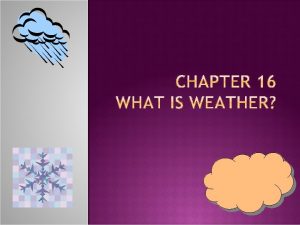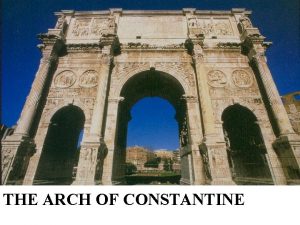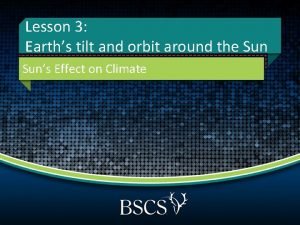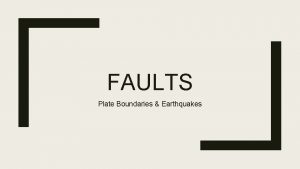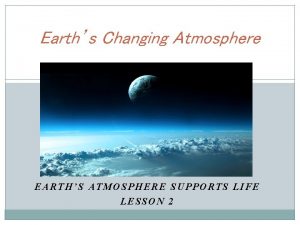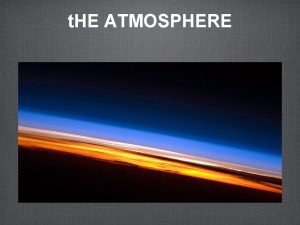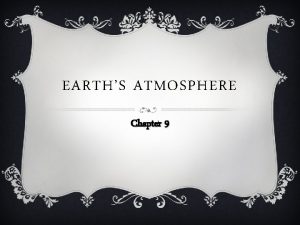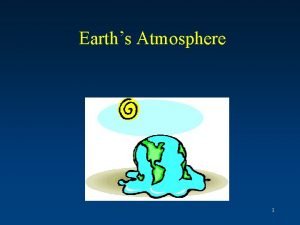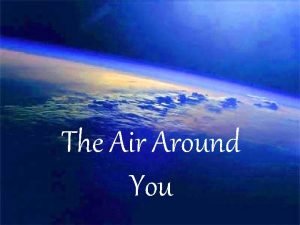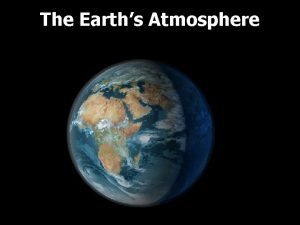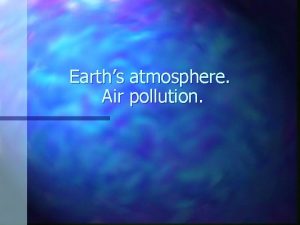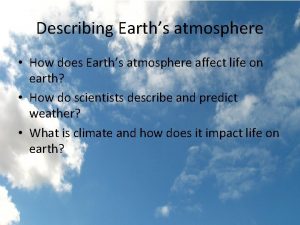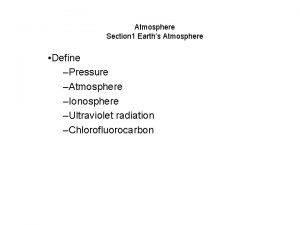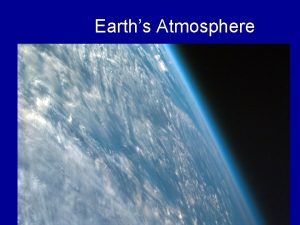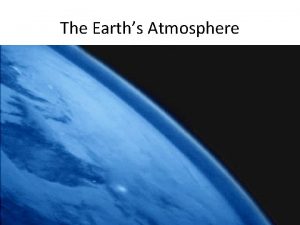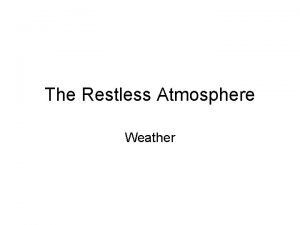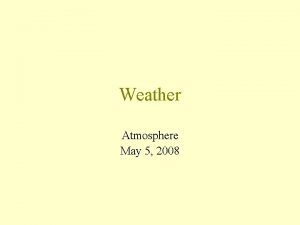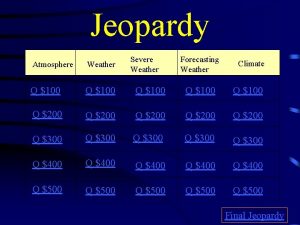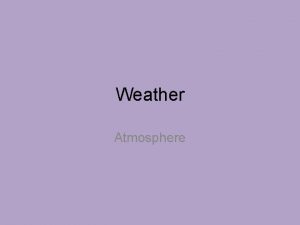Weather Chapter 1 The Atmosphere Earths Atmosphere Supports



























- Slides: 27

Weather Chapter 1: The Atmosphere

Earth’s Atmosphere Supports Life Read p. A 9 -A 11 to distinguish the two truths from the lie. 1. 2. 3. Air gets thinner the higher you go up a mountain. Air is mostly oxygen. Here is an analogy: earth : atmosphere : : peach : fuzz

What is the Atmosphere? Atmosphere is the envelope of essential gases that surround Earth In addition to these gases, particles of liquids, solids and water vapor can also be found in Earth’s atmosphere Our atmosphere makes conditions on Earth suitable for living

Characteristics of the Atmosphere As you increase your height above sea level (ALTITUDE), the air has less oxygen and is called “thinner. ” Altitude is the distance above sea level. The higher the altitude the less dense the air. The thickness of the air is determined by looking at its density, or the amount of material that is contained within a space. Think about a brick and a wooden block the same size. The brick has a greater density because there is more mass in the same size block.

Layers of Atmosphere Scientists divide Earth’s atmosphere into five main layers classified according to changes in temperature Troposphere Stratosphere Mesosphere Thermosphere Exosphere

Troposphere inner or lowest layer of Earth’s atmosphere the layer in which we live and our weather occurs as altitude increases, temperature decreases goes from Earth’s surface to approximately 10 km above the surface


Stratosphere extends from the top of the troposphere (10 km) to about 50 km above Earth’s surface The ozone layer protects us from the sun’s harmful ultraviolet (UV) rays. as altitude increases, temperature increases


Mesosphere begins 50 km from Earth’s surface and extends to 80 km considered to be the “middle” of the layers protects Earth from meteoroids as altitude increase, temperature decreases


Thermosphere the outermost layer of Earth’s atmosphere extends from 80 km into outer space ‘thermo’ means hot as altitude increases, temperature increases Includes the exosphere which is the outermost edge of the atmosphere This is the highest region in the atmosphere


Materials in the Atmosphere • Most of the atmosphere is composed of gases but there are some other solid and liquid particles, like dust and smoke. • Air • • • is. . . 78% nitrogen 21% oxygen 1% combined argon, carbon dioxide, and other gases • The amount of water vapor varies a lot depending on humidity.

Ongoing Processes in the Atmosphere Carbon Cycle Animals breathe in oxygen and release carbon dioxide. Plants breathe in carbon dioxide and release oxygen. This is a symbiotic relationship. We help one another. Nitrogen Cycle Microorganisms remove nitrogen from the air and change it into other chemicals, which are released into the soil. Living things then use this nitrogen. When they die, the nitrogen returns to the soil. Nitrogen from the soil is gradually released into the air. Water Cycle Precipitation Run off Evaporation Condensation

Carbon/Oxygen Cycle

Nitrogen Cycle

Water Cycle

Sudden Atmospheric Changes Volcanic eruptions, forest fires, and dust storms disrupt the normal atmospheric cycles and release substances and gases into the atmosphere.

Moving Energy – What’s the Difference? Convection Energy moving by heated gases and liquids Hot air rising and cool air sinking Conduction Energy that travels from one substance to another by direct contact Walking barefoot on hot sand Radiation Energy that travels in waves Sunlight warming the Earth

Gases in the Atmosphere Absorb Radiation The atmosphere can. . . 1. 2. 3. 4. Absorb light – take it in Reflect light – bounce it back off Let light pass through Give off light

Types of Radiation Ultraviolet Radiation Lots of energy “Ultra violent” Causes sunburn Infrared Radiation Low energy Night vision goggles

Ozone Made of three oxygen molecules stuck together The stratosphere has a collection of ozone called the OZONE LAYER. The Ozone Layer protects the Earth by absorbing bad UV radiation.

The Greenhouse Effect • Gases in the atmosphere keep energy close to the Earth’s surface. • The term GREENHOUSE EFFECT came from the way our atmosphere holds gases inside, much like the way a greenhouse maintains heat for its plants. • Greenhouse Gases. . . 1. 2. 3. 4. 5. • Most Carbon dioxide Methane Water vapor Nitrous Oxide Others greenhouse gases are in the atmospheric layer closest to Earth, the troposphere. • Greenhouse gases enable life to thrive on Earth. Without them, Earth would be too cold for life. • Over time, energy escapes into outer space. Otherwise, Earth’s temperature would rise higher and higher until life could not survive.

Human Activity Cause Air Pollution Air pollution refers to smoke and other harmful particles that are added to otherwise healthy air. Winds spread air pollution. Gas pollutants … 1. 2. 3. Methane Carbon monoxide Ozone Some are naturally occurring, like the methane produced by cows. Pollutants refer to when these particles cause harm. Ozone in the stratosphere is good but breathing it in is bad. PARTICULATES are the tiny particles or droplets that are carried in the air, like smoke, dust, pollen, salt, etc. Burning FOSSIL FUELS like coal and oil produce pollution. SMOG = smoke + fog Smog comes from both factories and cars.

Effects of Pollution Irritates eyes, nose, throat, lungs Smells bad Difficulty breathing Darkens skies Controlling Pollution Ozone alerts on the news warn people of unhealthy days. The Clean Air Act limits the amount of pollution factories are allowed to introduce into the air. Car inspection stickers Environmental Protection Agency (EPA) keeps track of pollution and enforces laws – big $$$ fines for breaking laws

Global Warming Earth can handle some greenhouse gases on its own. Nature contributes some of these gases. The problem occurs when Earth can’t keep up with the added demands that humans place on it. Due to the increase of greenhouse gases, Earth is slowly becoming warmer and warmer. This theory is called GLOBAL WARMING. CFCs (chlorofluorocarbons) in air conditioners, refrigerators, spray cans, and packaging materials increase bad chemicals in the air. Ozone levels vary across the globe. The South Pole has suffered greatly. Montreal Protocol was created in 1987 and includes 18+ nations. The MP asks companies to stop making and using chemicals that destroy the ozone layer.
 Earths early atmosphere contained
Earths early atmosphere contained High thin white feathery clouds called
High thin white feathery clouds called Earths layers foldable
Earths layers foldable Earths roation
Earths roation Whats earths moon called
Whats earths moon called Home sweet biome crossword
Home sweet biome crossword Most abundant element in earth crust
Most abundant element in earth crust Basalt
Basalt Whats earths moon called
Whats earths moon called Which layer of the earth slowly moves like putty
Which layer of the earth slowly moves like putty Which layers together constitute the lithosphere?
Which layers together constitute the lithosphere? Earths major crustal plates
Earths major crustal plates Earths orbit seasons
Earths orbit seasons Brown earth soil ireland
Brown earth soil ireland Earths physical features
Earths physical features Earths honey
Earths honey What is luna moon
What is luna moon Continental drift theory notes
Continental drift theory notes Earths crust
Earths crust Earths interior
Earths interior Spring earth tilt
Spring earth tilt What is atmosphere
What is atmosphere What is this shape
What is this shape The emperor constantine i recycled sculpture
The emperor constantine i recycled sculpture What does earths tilt do
What does earths tilt do Earths boundaries
Earths boundaries Earths 4 spheres
Earths 4 spheres Weather symbols on a station model
Weather symbols on a station model

